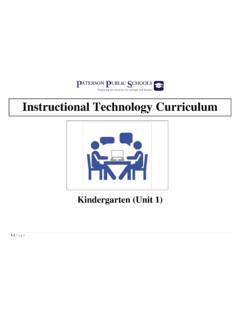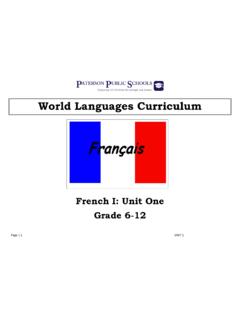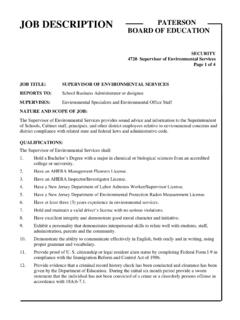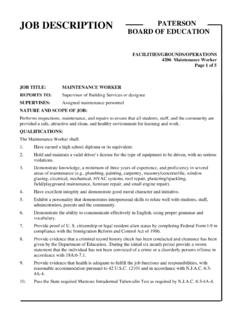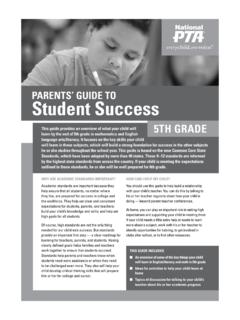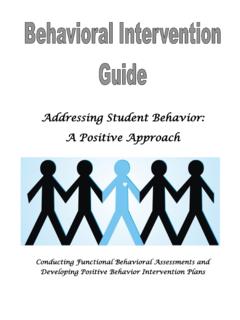Transcription of Department of College and Career Readiness Medical …
1 1 | Page Department of College and Career Readiness Medical Terminology Curriculum Credits Unit One 2 | Page Medical Terminology Course Description Medical terminology course is designed to introduce students to basic Medical language and terminology that they would need to enter a health care field. Emphasis will be placed on definitions, proper usage, spelling, and pronunciation. Students will employ a systematic word-building approach to master the complex terminology that pertain to body systems, anatomy, physiology, Medical processes and procedures as well as a variety of diseases.
2 The course includes but is not limited to terms related to anatomy of the human body, functions of health and disease, and the use of language in processing Medical /dental records as well as claim forms. This course is recommended for 9 to 12 grade level students and consists of four units. Upon completion of this course the student should be able to understand the necessity of Medical vocabulary, build Medical words from component parts, and explain the meaning associated with each unit and identify and discuss basic pathology associated with all entities. 3 | Page Medical Terminology pacing guide Unit Topic Suggested Timing Unit 1 Basic Word Structure and Body Organization approx.
3 4 weeks Unit 2 Anatomic References and Body Systems I approx. 8 weeks Unit 3 Anatomic References and Body Systems II approx. 13 weeks Unit 4 Medical Specialists and Case Reports approx. 10 weeks 4 | Page Educational Technology Standards , , , , , Technology Operations and Concepts Create a personal digital portfolio which reflects personal and academic interests, achievements, and Career aspirations by using a variety of digital tools and resources. Creativity and Innovation Apply previous content knowledge by creating and piloting a digital learning game or tutorial.
4 Communication and Collaboration Develop an innovative solution to a real world problem or issue in collaboration with peers and experts, and present ideas for feedback through social media or in an online community. Digital Citizenship Demonstrate appropriate application of copyright, fair use and/or Creative Commons to an original work. Research and Information Literacy Produce a position statement about a real world problem by developing a systematic plan of investigation with peers and experts synthesizing information from multiple sources.
5 Critical Thinking, Problem Solving, Decision Making Evaluate the strengths and limitations of emerging technologies and their impact on educational, Career , personal and or social needs. 5 | Page Career Ready Practices Career Ready Practices describe the Career -ready skills that all educators in all content areas should seek to develop in their students. They are practices that have been linked to increase College , Career , and life success. Career Ready Practices should be taught and reinforced in all Career exploration and preparation programs with increasingly higher levels of complexity and expectation as a student advances through a program of study.
6 CRP1. Act as a responsible and contributing citizen and employee Career -ready individuals understand the obligations and responsibilities of being a member of a community, and they demonstrate this understanding every day through their interactions with others. They are conscientious of the impacts of their decisions on others and the environment around them. They think about the near-term and long-term consequences of their actions and seek to act in ways that contribute to the betterment of their teams, families, community and workplace. They are reliable and consistent in going beyond the minimum expectation and in participating in activities that serve the greater good.
7 CRP2. Apply appropriate academic and technical skills. Career -ready individuals readily access and use the knowledge and skills acquired through experience and education to be more productive. They make connections between abstract concepts with real-world applications, and they make correct insights about when it is appropriate to apply the use of an academic skill in a workplace situation. CRP4. Communicate clearly and effectively and with reason. Career -ready individuals communicate thoughts, ideas, and action plans with clarity, whether using written, verbal, and/or visual methods.
8 They communicate in the workplace with clarity and purpose to make maximum use of their own and others time. They are excellent writers; they master conventions, word choice, and organization, and use effective tone and presentation skills to articulate ideas. They are skilled at interacting with others; they are active listeners and speak clearly and with purpose. Career -ready individuals think about the audience for their communication and prepare accordingly to ensure the desired outcome. CRP6. Demonstrate creativity and innovation. Career -ready individuals regularly think of ideas that solve problems in new and different ways, and they contribute those ideas in a useful and productive manner to improve their organization.
9 They can consider unconventional ideas and suggestions as solutions to issues, tasks or problems, and they discern which ideas and suggestions will add greatest value. They seek new methods, practices, and ideas from a variety of sources and seek to apply those ideas to their own workplace. They take action on their ideas and 6 | Page understand how to bring innovation to an organization. CRP8. Utilize critical thinking to make sense of problems and persevere in solving them. Career -ready individuals readily recognize problems in the workplace, understand the nature of the problem, and devise effective plans to solve the problem.
10 They are aware of problems when they occur and take action quickly to address the problem; they thoughtfully investigate the root cause of the problem prior to introducing solutions. They carefully consider the options to solve the problem. Once a solution is agreed upon, they follow through to ensure the problem is solved, whether through their own actions or the actions of others. CRP10. Plan education and Career paths aligned to personal goals. Career -ready individuals take personal ownership of their own education and Career goals, and they regularly act on a plan to attain these goals.
